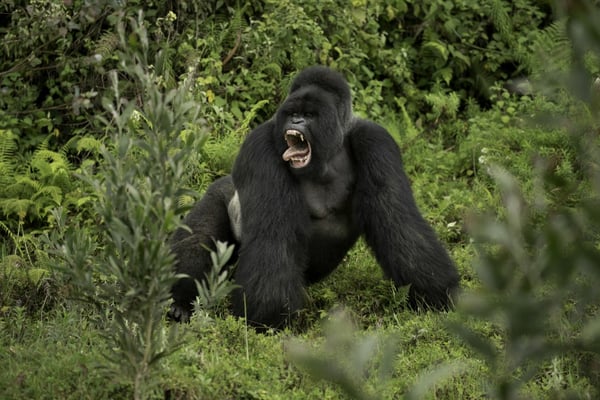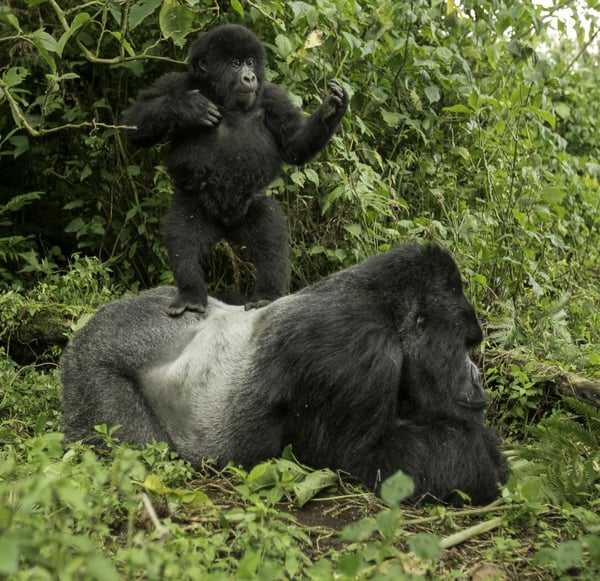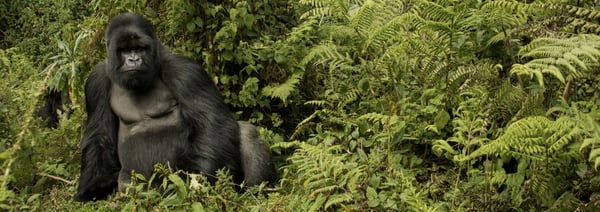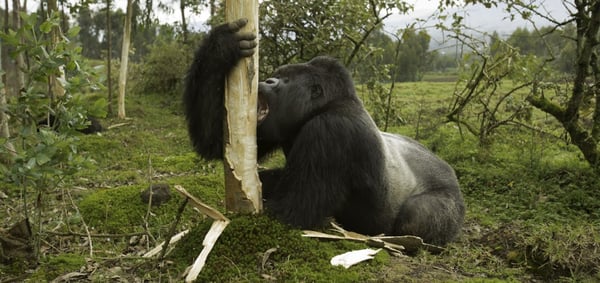Behind the Shot with Joe McDonald
Behind the Shot With Joe McDonald
While all wildlife experiences are special in some way, there is one that most folks find to be without parallel, and that’s being in the company of the endangered Mountain Gorilla. My wife Mary Ann and I have been fortunate to have completed, to date, 85 treks, as the visits are called, over about a ten year period. Except for the researchers who are there daily, we’re told we have the most visits. Which brings up the questions, why so many, and doesn’t it get repetitive?
One response answers both inquiries, and that is the experience is never the same. Each trek offers something different and special, and no matter how many visits one might do there is always either the potential or the reality of a truly magical moment, photographic or otherwise. On our 75th trek, for example, we were fortunate to have two family groups, called Sabyinyo and Kwitonda, meet up in a farm field, and the sparks flew! Normally groups keep their distance, as the dominant silverback wants to keep his harem to himself, and it’s too easy to lose a female or two to a rival, either forcefully or, quite often, via the female’s own initiative. These encounters are rare, and most take place deep in the forest where visibility can be extremely limited, but on this day the meeting occurred completely in the open. Over the next forty minutes or so the three males of the Sabyinyo group postured aggressively, trying to intimidate the huge, lone silverback of Kwitonda. I was surprised at how little contact there was between the males, and only twice did the silverbacks actually come together. On one occasion the silverbacks ran towards each other and slapped, seemingly high-fiving as they passed by. On another, apparently the excitement was too much to merely posture and two gorillas clashed, screaming and slapping and attempting to bite as they rolled down hill, with Sabyinyo’s other males and blackbacks rushing in to help. The fight broke up within seconds, and no damage was done to either side.

Silverback gorilla from Kwitonda group confronting another family group, Sabyinyo, in a threat display involving barred teeth and tongue wagging.
Gorilla trekking is expensive, now a crazy $750 US/day, and people might be tempted to do just one or two treks because of the cost, but we don’t recommend it. Conditions are too variable to put all your apes in one basket, as a number of factors could conspire to make the shooting less than perfect. It might rain, and the gorillas might be huddled under a tree for shelter. Or it might be perfectly clear, and the bright sunlight could create very harsh lighting conditions. Gorillas might be feeding or resting in a dark bamboo forest, where the shutter speeds might be extremely slow, or they might be on the move, where keeping up with a group traveling through their element, not yours, is a real challenge. But if you budget for a couple of days the chances are you’ll have cloudy-bright light and gorillas in a forest clearing at least once. Sometimes you’ll have ideal conditions for every trek, and that’s just great, but it is wise to expect less than perfect situations some days and plan enough treks to compensate.
It might be tempting to hand-hold your camera and we’ve had participants on our treks do just that, claiming they can hold their cameras very still. I don’t believe it. Light levels can be very low in the forest, and even if the gorillas aren’t moving you very well may be. You might feel yourself shaking, either from excitement at being so close to these magnificent animals or from the physical exertion that was involved in following the gorillas. Obtaining a sharp image requires a camera capable of using a high ISO when necessary, (we’ve often shot at ISO 2000 and 3200), and a sturdy camera support.
I’ve always been a real stickler for image sharpness, and to me that always has meant using a tripod. For years we used a tripod and ballhead on our gorilla treks, which did provide the necessary support but at a real cost in terms of convenience. Gorilla photography can be extremely fluid, as you may be following a moving group that pauses only long enough for a couple of shots before they continue on, or the best angles may be at full tripod extension one moment, and almost at ground level the next. Factor in trying to anchor three tripod legs on a mat of springy, matted vegetation, or maneuvering the tripod itself when going through bamboo and vines and shrubs … well, you get the picture. Or rather, you may not!
A couple of years ago I started using a RRS monopod with a MH-01 Pro Monopod Head to make my shooting much more efficient. I should have done so years earlier, for the monopod provided the necessary support while minimizing the headaches of working in gorilla country. You might be tempted to mount your ballhead on the monopod to save money or to minimize the amount of gear you take, but I wouldn’t recommend it. The MH-01 Pro monopod head gives you the flexibility you need without the ‘floppiness’ of a loose ballhead, which is almost guaranteed to pinch the skin web between your thumb and index finger at some point. By rotating the lens inside its tripod collar, or by simply tilting the monopod one way or the other, or rotating the head’s camera platform, I have complete flexibility, with very few hassles and no compromises.
There are a couple of choices for lenses. Mary uses a 28-300mm for the wonderful flexibility that zoom range offers, while I prefer to use two cameras instead, one with a 24-105mm or 16-35mm, and the other with my very sharp 70-300mm telephoto. Although technically tourists are supposed to be seven meters from the gorillas these great apes never read the rules, and often stroll so close by that a wide angle lens is extremely handy to have at the ready. A medium telephoto will probably see the most use, for portraits and the shots at the seven meter distance.
Gorilla viewing is limited to only one hour, but the entire experience from registration at Park Headquarters to hiking through the farm fields to reach the forest and returning will easily occupy an entire morning, at least. If the group you are visiting is deeper in the forest, or higher up the volcano slopes, you could be out all day. Physically, trekking isn’t too difficult, provided you are in some sort of shape, and walking a couple of flights a day for conditioning beforehand does not qualify here. However, if you go for long walks and can do some hills, or do several flights a day in an office building, you’ll be prepared, and the experience will be even more enjoyable. And that, my friends, it certainly is!





